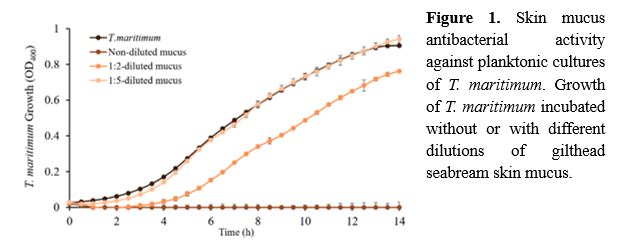BIOFILM FORMATION OF Tenacibaculum maritimum, A FISH PATHOGENIC BACTERIA, TO EVALUATE THE ANTIMICROBIAL ACTIVITY OF FISH SKIN MUCUS
Introduction
Tenacibaculum maritimum is a Gram-negative filamentous bacterium that accounts for the majority of tenacibaculosis cases in marine fish species (Mabrok et al., 2023). Although biofilm formation is presumably a necessary step in the establishment of the infection by Tenacibaculum (Levipan et al., 2019), biofilms have not been usually included in studies assessing the antibacterial activity of fish skin mucus against this pathogen. In this context, the present study aimed to establish a simple and reproducible protocol for the formation and quantification of T. maritimum biofilms that will allow a more realistic approximation when studying the antibacterial properties of different compounds against this pathogen. For this purpose, a first attempt to elucidate the effects of gilthead seabream (Sparus aurata) skin mucus on T. maritimum planktonic and biofilm growth was included.
Materials and methods
This study developed an evaluation of skin mucus antibacterial activity on planktonic cultures, on biofilm formation and on mature biofilms of Tenacibaculum maritimum (CECT 4276 strain from the Spanish Type Culture Collection University of Valencia, Spain). To do this, an experimental setup for the biofilm formation has been developed. A pool of homogenized skin mucus of gilthead seabream juveniles (S. aurata) was created and three different dilutions were tested in the antibacterial assays. The activity of skin mucus on biofilms was monitored through Crystal Violet staining (biomass) and resazurin assay (metabolic activity).
Results
The results obtained demonstrated that seabream mucus significantly impairs the planktonic growth of T. maritimum in a concentration-dependent manner: non-diluted mucus (9.6 mg ml-1) completely inhibited T. maritimum growth, 1:2-diluted mucus initially caused high inhibition that was reduced during the later hours of culture, and a 1:5 dilution of the mucus resulted in an almost complete loss of antibacterial activity (Figure 1).
The antimicrobial effect of the fish skin mucus on the biofilm formation showed similar results to those obtained with planktonic cells. Non-diluted mucus strongly inhibited biofilm formation: a high reduction in biofilm biomass was observed and no metabolic activity was detected. The inhibitory effect decreased when 1:2-diluted mucus was used and lost with the 1:5-dilution. Undiluted gilthead seabream skin mucus demonstrated significant effects on mature biofilms, promoting substantial biofilm biomass dispersion (40%) and reducing the metabolic activity by approximately 50%. In contrast, diluted mucus appears not to affect biofilm biomass and viability in the dispersion assay.
Discussion and conclusions
Bacterial biofilms constitute significant challenges in medical and ecological contexts due to their remarkable ability to resist antibiotic treatments, leading to persistent infections (Flemming et al., 2016). This study aimed to provide a platform for studying the potential antimicrobial effects of fish skin mucus on the formation and dispersion of biofilms of T. maritimum. The results showed that the mucus inhibited biofilm formation in a concentration-dependent manner. Considering the effect of skin mucus on planktonic growth, the inhibition of biofilm formation observed could be a consequence of the inhibition of total bacterial growth in the presence of the skin mucus. Our results demonstrated that, in addition to inhibit biofilm formation, seabream skin mucus could alter previously formed T. maritimum biofilms. However, as expected, the impact of skin mucus on the disaggregation of T. maritimum pre-formed biofilms was found to be less pronounced, evidencing the high resistance that these structures confer to the bacterial cells. Assessing how fish culture conditions influence the host’s vulnerability to bacterial infections is essential to prevent economic losses in fish farms. The protocols developed here will provide functional and reliable tool to monitor fish vulnerability to this pathogen and to study ‘ex vivo’ the benefits of functional feeds. In addition, gilthead seabream skin mucus could represent a potential source of new therapeutic compounds for treating biofilms of this pathogen, due to its effect on established biofilms.
References
Flemming, H.-C. et al., 2016. https://doi.org/10.1038/nrmicro.2016.94
Levipan, H.A. et al., 2019. https://doi.org/10.1016/j.aquaculture.2019.734267
Mabrok, M. et al., 2023. https://doi.org/10.3389/fcimb.2022.1068000
